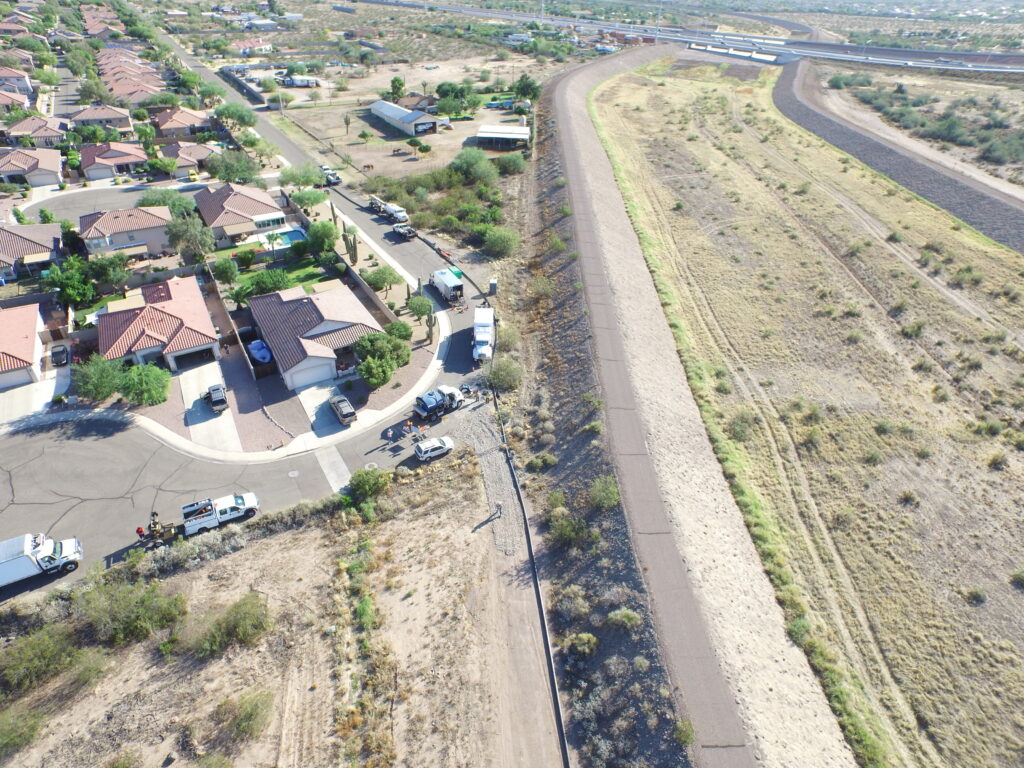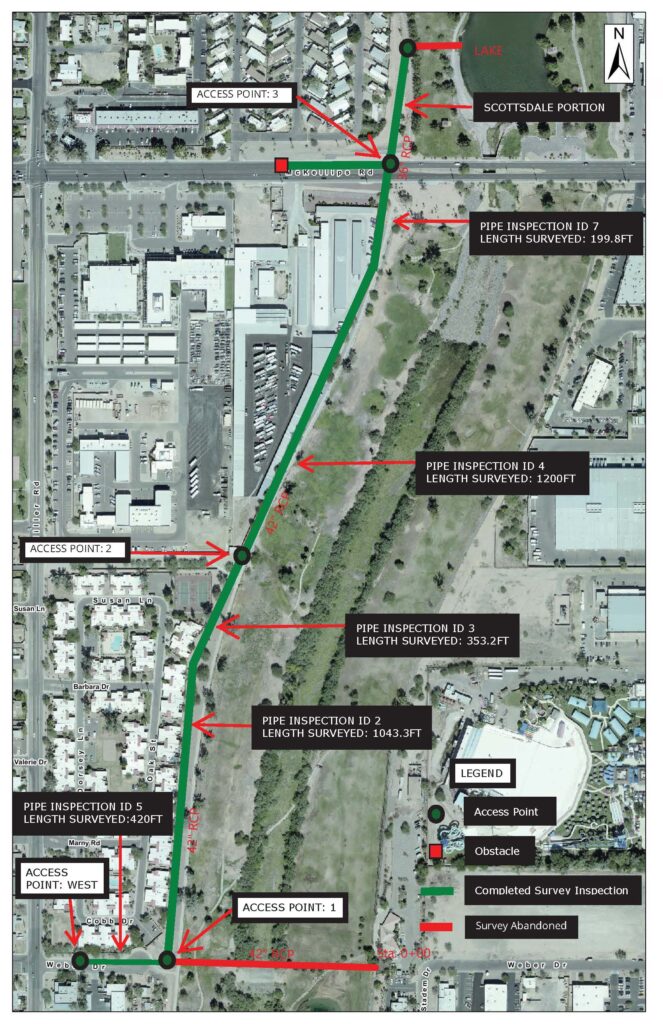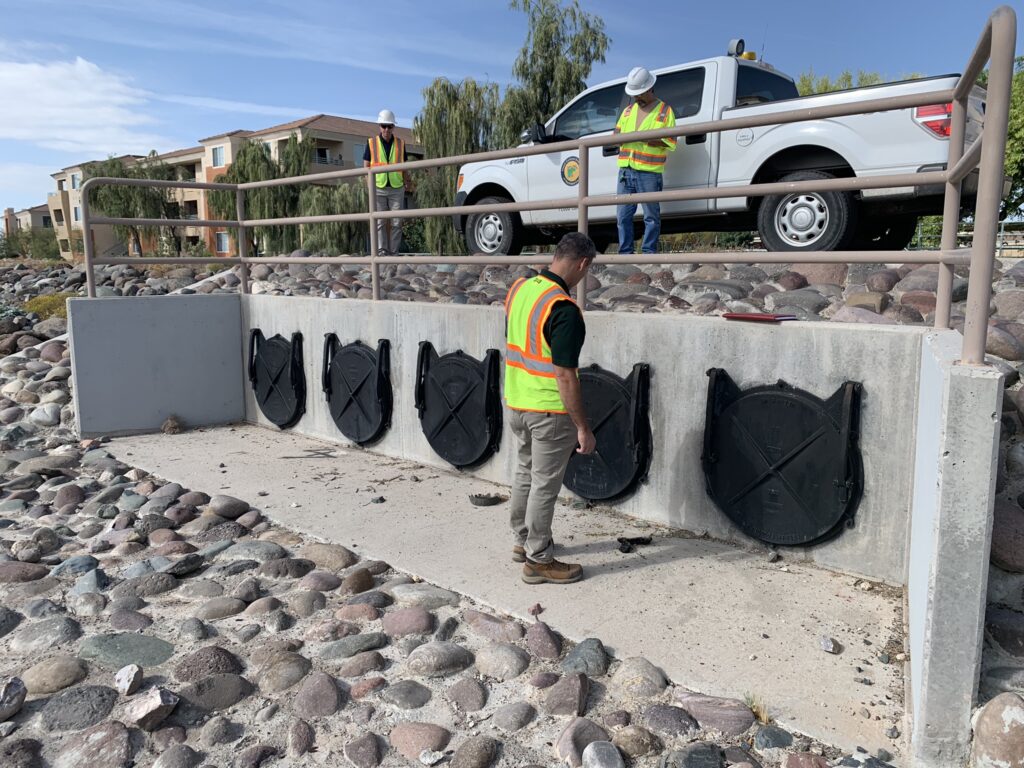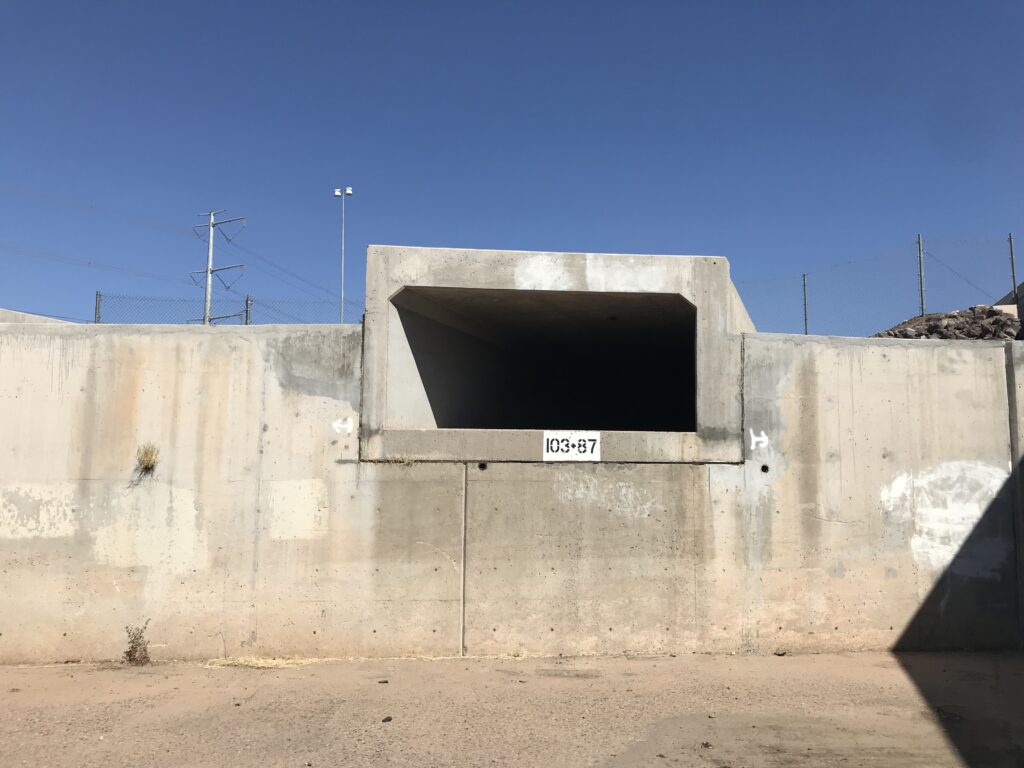Levee System Inspection – Flood Control District of Maricopa County
Inspection and maintenance are critical to levee systems to maintain flood insurance status.
Written by: Marc Nelson, PE | Susanna Mabery

Introduction
Residential areas that experience large amounts of flooding due to storm events often use channelization of affected washes to help provide flood control. A common feature for channeling floodwater is a levee, which is a man-made structure designed to contain, control, or divert the flow of water to reduce the risk of flooding. A levee is typically an earthen embankment, but sometimes includes stone (rip-rap) or grouted stone (grouted rip-rap).
The National Flood Insurance Program (NFIP) is a Federal Emergency Management Agency (FEMA) program that offers federally backed flood insurance to homeowners, renters, and business owners that reside in communities that participate in their program. Communities using this program adopt and enforce floodplain management practices to reduce the occurrence of flood damage to their properties.
Flood Insurance Rate Maps (FIRMs) are used by FEMA to identify areas that are at risk for flooding and help communities to identify the need for obtaining flood insurance.
The Flood Control District of Maricopa County (FCDMC) owns, operates, and maintains a number of levee systems in the Phoenix area. The channels and levees were designed by the U.S. Army Corps of Engineers (USACE). These levees are active in the USACE Rehabilitation Program and are shown on the FEMA FIRMs as providing a benefit to the residents within the leveed areas. For a levee to maintain the FEMA accredited FIRM status, levees must have met and continue to meet minimum regulatory standards. Thus, regular maintenance is required to prevent levee failures, maintain safety to nearby residents, and to stay active in the NFIP.
Two levee systems required assessment to determine if their structural integrity sufficiently meets the standards by the USACE and maintain the FEMA FIRM status.
- Indian Bend Wash, spanning between Scottsdale and Tempe
- Skunk Creek, located in north Phoenix
Method
A National Association of Sewer Service Companies (NASSCO) standard assessment is required by the USACE for inclusion in the quinquennial Project Inspection Report (PIR) to assess the integrity of the levee systems and make recommendations for maintenance to reduce the flooding risk to the public. Visual condition assessments were performed by Dibble on the two previously identified levee systems owned by the FCDMC. The condition assessment involved side inlet pipe inspection including:
• Data collection using camera inspection (CCTV) or manned entry for larger diameter pipes
• Detection of debris accumulation
• Development of assessment report identifying internal pipe conditions
Observed defects are documented per NASSCO and Pipeline Assessment Certification Program (PACP) standards. NASSCO PACP® codes are assigned to defects that are observed from visual assessments within the pipe. The defect codes have corresponding condition grades assigned to them base on the severity of deterioration. Table 1 describes the assigned condition grades. Defect coding for pipes penetrating levees is more severe than defect coding for typical sewer or storm drainpipes and is elevated by one (1) grade when in a levee.
| Grade | Condition | Condition Definition |
| 5 | Extremely Poor | Most Significant Defect |
| 4 | Poor | Significant Defect |
| 3 | Fair | Moderate Defect |
| 2 | Good | Minor to Moderate Defect |
| 1 | Excellent | Minor Defect |
To assign a specific grade to the assessed pipe, three (3) rating indexes are used: Structural, Operational & Maintenance (O&M), and Overall. The indexes are determined by multiplying the condition grade by the number of defects of that grade then dividing that by the total number of defects.
Inspection Assessment
Indian Bend Wash Levee System
The Indian Bend Wash is a flood control channel that runs from Indian Bend Road, in the City of Scottsdale, south through the City of Tempe to the Salt River. Five components are included in the channel: a greenbelt, an inlet channel, an outlet channel, an interceptor channel, and collector and sides channels. The inlet is located at Indian Bend Road and extends for one mile along an unlined earthen channel. Stretching from McKellips Road to the Salt River (the project’s outfall) the outlet is also an unlined earthen channel. The interceptor, side, and collector channels collect stormwater and convey it to the main channel.

Inspection assessment of the 24-inch pipe penetrations to the Indian Bend Wash1 (IBW1) Levee System began within the City of Scottsdale, upstream of McKellips Road moving southbound to the City of Tempe, downstream of McKellips Road. The channel in this area is a trapezoidal shape with an earthen levee. The inlet pipes are owned by the Salt River Project (SRP) and were put in place prior to the construction of the levee. Pipe inlet origination is in McKellips Lake and acts as an irrigation reservoir for SRP. Assessment of the IBW1 inlet pipes continued south, into the City of Tempe’s jurisdiction.
The pipe material is Reinforced Concrete Pipe (RCP) and is approximately 45 years old. SRP performs an annual “dry up” to restrict flow in pipes and allow for regular maintenance and inspection. Assessment of the pipes was specifically scheduled to occur during this period.
Prior to the camera inspection, the Dibble team cleaned the pipes and access points as thoroughly as possible, prior to the dry up period. A subconsultant to Dibble, AIMS Companies collected images of the pipe interiors, using digital CCTV camera equipment for interior dimensional measurements, closer visual scrutiny of defects, and documentation of conditions. Dibble staff, certified by NASSCO’s PACP program, remained on-site during the camera inspection. Following the digital data collection, Dibble evaluated the existing pipe conditions and coded the observed defects in accordance with the NASSCO PACP standard procedures as identified in the previous table.
Skunk Creek Levee System
The USACE designed the Skunk Creek Levee System as part of a channelization project to convey flow under Interstate 17 (I-17) near the Jomax Road intersection. Prior to its construction, the area surrounding the leveed area was mostly uninhabited. However, today the Levee System provides flood risk management for nearby residences. The channelization consists of both trapezoidal and rectangular shapes. Earthen levees line the trapezoidal section, with stone (rip-rap) or grouted stone (grouted rip-rap) as the primary materials used to construct the channel. Floodwalls and reinforced-concrete pavement make up the rectangular channelization areas. There are two levees in this system, Skunk Creek 1 (SK1) on the west side of the channel and Skunk Creek 2 (SK2) on the channel’s east side. SK2 does not contain any inlet pipes. The side inlet pipes in SK1 require inspection to maintain flood insurance benefits.
The assessment and inspection of this levee system occurred in two phases:
- Part 1: CCTV assessment of one, 24-inch and five, 30-inch inlet pipes, under FCDMC jurisdiction
- Part 2: Manned entry assessment of a 66-inch pipe and a 10-foot by 5-foot box culvert, under Arizona Department of Transportation’s (ADOT) jurisdiction

Part 1 of the assessment, consisting of the 24- and 30-inch reinforced concrete inlet pipes, included AIMS Companies to collect images of the pipe interiors using digital CCTV camera equipment for interior dimensional measurements, closer visual scrutiny of defects, and documentation of condition. The team cleaned the pipes prior to inspection. Dibble staff, certified by NASSCO’s PACP program, remained on-site during the camera inspection.
Part 2 of the assessment included manned entry of a 66-inch RCP and a 10-foot wide by 5-foot high concrete box culvert (CBC). ADOT constructed both the RCP and CBC storm drains as part of the drainage system for this portion of I-17. Differing from the previous assessments, a Dibble structural engineer performed this assessment, which included visual and limited non-destructive hammer sounding inspection. The structural engineer used four standard condition states to define the level of defect in each structure, based on publication No. FHWA-NHI-15-039 and FHWA-NHI-130055: Condition State 1 (CS1) – Good, Condition State 2 (CS2) – Fair, Condition State 3 (CS3) – Poor, and Condition State 4 (CS4) – Severe.

Results
Indian Bend Wash Levee System
The assessment of the IBW1 levee system residing in the City of Scottsdale portion identified Structural and O&M defects as defined by NASSCO. Structural defects included longitudinal cracking, multiple cracks, and surface aggregate visible. Each of these defects carries a defect score of 3, as defined in the condition grades table. O&M defects are deposits settled fine and deposits settle gravel, which both carry a NASSCO score of 2. The cracking and deposits of gravel are typical in this type of pipe, classifying the defects as minor and do not require immediate rehabilitation. Areas that contain exposed aggregate defects will eventually lead to a deteriorating effect, exposing the reinforced steel. This pipe section should be monitored more frequently, possibly less than every five years. Once reinforcement is visible and exposed, NASSCO strongly recommends repair or rehabilitation.
The City of Tempe IBW1 levee system assessment discovered both structural and O&M defects. The Dibble team observed the most common structural defects to be longitudinal cracking, with a NASSCO defect score of 3, and fracture defects that rank a NASSCO defect score of 4. O&M common defects included roots fine joint that have a NASSCO defect score of 4. Two sections of pipe included a combination of cracking and root defects and the potential for root growth to create further deterioration of cracks or fracture defects. In these sections, Dibble recommended to install cured in place pipe (CIPP) lining to prevent further deteriorations.
Skunk Creek Levee System
The Skunk Creek, Part 1 assessment observed minor defects in the five, 30-inch RCP inlets, concluding with no immediate rehabilitation action needed. The team observed more severe defects in the 24-inch RCP that warranted a recommended rehabilitation method of lining the existing pipe with CIPP. Dibble recommended the repair be done within a year of the assessment results to preclude further damage and possible risk of failure.
Skunk creek, Part 2 assessment results consisted of multiple structural defects throughout both the RCP and the CBC. Defects included cracking in the ceiling, walls and floor; efflorescence at the joints and cracks; rust staining around joints and cracks; deteriorated joint material and in adjacent concrete to the joints; and water leaks through the ceiling joints and cracks. The structural engineer provided recommendations for general structural repair, based on the assessment reported, to the FCDMC. The CBC and RCP segment joints that have defects, as well as all cracks, should be repaired prior to the next required inspection of five years. Prior to these repairs, it is recommended that any efflorescence build-up, dirt, or debris in the joints or cracks be removed.
Conclusion
Given the nature of the inlet pipes and their primary goal to convey stormwater to channelized areas, the probability of cracking, sediment buildup, and root penetration can be common. While the cracks and sediment buildup identified during the assessment performed by Dibble do not require immediate rehabilitation, it is recommended that inspection and cleaning of the inlet pipes occur on a periodic basis, with the maximum requirement of every five years to meet FEMA requirements, to maintain the integrity and function of the pipes. Failure to perform recommended rehabilitation efforts will continue to deteriorate the defects and lead to pipe failure and potential levee failure over time. Sections with observed defects should receive maintenance, and the reinspection of pipes, including cleaning, should be performed on a routine basis.
With proper maintenance and inspection, the levee systems should continue to provide protection for nearby residents and remain in compliance with the NFIP.
Markets Mentioned
Infrastructure Rehabilitation
Services Mentioned
Infrastructure Rehabilitation
This Case Study PDF
Project Details
Project
Levee Pipe Assessments
Location
Scottsdale/Tempe/Phoenix, AZ
Owner
Flood Control District of Maricopa County
Market
Infrastructure Rehabilitation
Engineer
Dibble
Delivery
Job-Order-Contract (JOC)

